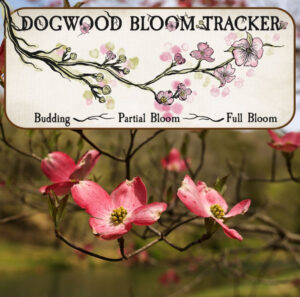Dogwood Canyon Blog
Flowering Dogwood Trees Are Soon to Bloom!
April 1, 2024
One of the most beloved sights at Dogwood Canyon are the beautiful flowering dogwood trees when they are in full bloom. Five dogwood tree species are scattered across Missouri, and the flowering dogwood is the one most commonly found throughout the canyon. Each spring, typically between mid-April and mid-May, Missouri is decorated with these iconic pink or white blossoming trees. There’s a reason why they are recognized as the state tree!
Dogwood trees have played a key role in medicine, conservation, and connecting people with nature. To relieve headaches, toothaches, fevers, and other pains, Native Americans chewed the bark to promote the release of pain-reducing compounds. Since the trees’ bark is so sturdy and tough, arrow shafts, daggers, and other tools were carved from it. The Chippewa’s and the Ojibwa’s mixed the inner bark of redosier dogwoods with other plants and minerals to make red, light red, black, and “khaki” colored dyes. Additionally, their consistent bloom each spring was a signal to begin planting corn for the late summer to early fall harvest. Colonists in the late 1700’s would make tea from dogwood bark to reduce fevers and soothe colds.

Flowering dogwood trees also benefit wildlife year-round. They produce bright red fruit in the fall that are considered a tasty snack by many critters like chipmunks, foxes, squirrels, deer, rabbits, and skunks. Birds, like wild turkeys, also forage for their fruit. Insects will eat or drink the sap produced by dogwood trees, and most of them will then become food for birds and other insect-eating animals. Many ecosystems that contain dogwood trees thrive because they are a food source for animals, which is why it is important to protect them.
Despite their positive impact on nature, and their significance in many ecosystems, flowering dogwood trees have been greatly impacted by a disease called dogwood anthracnose. Caused by a fast-spreading fungus, signs of this disease include small, tan leaf spots which eventually grow to larger blotches. The disease eats away healthy tissues in their leaves and will then spread to its twigs and stems. Dogwood trees are more susceptible in cooler, wet weather during the spring and fall, and they should be planted in open, sunny sites to avoid shady areas which promote the growth of fungus.
As a symbol of spring, people love to view the white or pink blossoms that decorate the Ozark Mountains landscape. We invite you to behold the picturesque views as the flowering dogwood trees bloom across the canyon. You can book any of our guided tours or explore our hiking trails to make the most out of your visit. We are already seeing the first signs of dogwood flowers, which is about a month earlier than usual. You can follow us on Instagram @dogwood_canyon or Facebook to receive weekly updates about their bloom progress with our ‘Dogwood Blooms Tracker’. Make sure you don’t miss this exciting season at Dogwood Canyon!

Our dogwood trees are officially in full bloom as of the week of April 15th, 2024.
